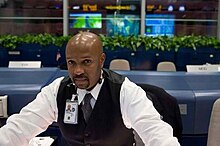Early NASA career
Alibaruho started with NASA in 1993 as a Cooperative Education student serving in the Mission Operations Directorate's ISS Life Support Systems Group. Post-graduation, he serviced as an ISS Life Support Systems Flight Controller (MCC Call Sign: ECLSS) from 1995–2000. During that time, Alibaruho became one of the first ECLSS officers qualified for duty in the new International Space Station Program and served on missions ISS-1A/R, STS-88/ISS-2A, STS-101/ISS-2A.2a, STS-106/ISS-2A.2b, STS-97/ISS-4A, STS-105/ISS-5A.1.
In May 2001, Alibaruho was selected as the Manager of the ISS Life Support Systems Group where he managed and trained a team of approximately 25 Flight Controllers. He served in this capacity for just over three years until he was selected as a Flight Director in February 2005.
As of November 2005, only 58 people had directed human spaceflight missions. The Flight Director class of 2005, of which Alibaruho is a member, is the second largest ever appointed and the most diverse. The nine-member group also included three women and two Hispanics. Leading a team of flight controllers, support personnel and engineering experts, a flight director has the overall responsibility to manage and carry out Space Shuttle flights and International Space Station expeditions. A flight director also leads and orchestrates planning and integration activities with flight controllers, payload customers, space station partners and others.
Flight Director career
By August 2005, Alibaruho had completed more than 700 hours of training as an International Space Station Flight Director and reported for active duty in Mission Control immediately following completion of NASA's "Return-to-flight" mission, STS-114 / LF-1, a flight led by his longtime mentors Paul Hill and Mark Ferring.
Shortly after, Alibaruho completed training as a Space Shuttle Flight Director, now qualified to manage operations on both spacecraft. During his Flight Director career, Alibaruho served as an Orbit ISS Flight Director for Assembly Missions STS-115 / ISS-12A and STS-123/ISS-1J/A. He served as an Orbit ISS Flight Director for Expeditions 11 – 28, logging literally hundreds of shifts in Mission Control. Alibaruho served as a Shuttle Orbit Flight Director for Missions STS-126 / ULF-2, STS-127 / ISS-2J/A, STS-128 / ISS-17A, and STS-134 / ULF-6.
During his tenure, Alibaruho served as the Lead ISS Flight Director for Russian EVA 15 and for STS-119 / ISS-15A, the mission which delivered the S6 Solar Array & Truss Segment to the International Space Station. As a Space Shuttle Flight Director, Alibaruho also served as the Lead Flight Director for Mission STS-130 / ISS-20A, the mission that delivered the Node-3 and Cupola to the International Space Station.
After STS-130, Alibaruho was selected to serve a 7-month temporary assignment as Deputy Chief of the EVA, Robotics, and Crew Systems Operations Division, where he assisted the Division Chief in management of approximately 200 civil service and contractor personnel and the Division’s two major facilities, the Neutral Buoyancy Laboratory (NBL) and the Space Vehicle Mockup Facility (SVMF).
As his temporary assignment as Deputy Division Chief concluded, NASA directed the addition of one final Space Shuttle Flight to the Program Manifest, STS-135 / ULF-7, which was to be the last Shuttle Flight in U.S. history. Senior Management of Mission Operations Directorate selected Alibaruho to serve as the Lead Space Shuttle Flight Director for this historic mission alongside Lead ISS Flight Director, J. Chris Edelen.

Janet Lynn Kavandi, a native of Carthage, Missouri, is an American scientist and a NASA astronaut. She is a veteran of three Space Shuttle missions, served as NASA's Deputy Chief of the Astronaut Office, and was the Center Director at the NASA Glenn Research Center in Cleveland, Ohio from March 2016 until her retirement from NASA in September 2019. She was inducted into the United States Astronaut Hall of Fame in 2019.

Brewster Hopkinson Shaw Jr. is a retired NASA astronaut, U.S. Air Force colonel, and former executive at Boeing. Shaw was inducted into the U.S. Astronaut Hall of Fame on May 6, 2006.

Michael Allen Baker is a retired captain in the United States Navy, former NASA astronaut, and the International Space Station Program Manager for International and Crew Operations, at NASA's Johnson Space Center. He is responsible for the coordination of program operations, integration and flight crew training and support activities with the International Partners.

Robert Donald Cabana is a former Associate Administrator of the National Aeronautics and Space Administration (NASA), NASA astronaut and non-flight-eligible management astronaut), and is a veteran of four Space Shuttle flights. He served as Chief of the Astronaut Office from 1994 to 1997 and as director of the John F. Kennedy Space Center from 2008 to 2021. He is also a former naval flight officer and naval aviator in the United States Marine Corps.
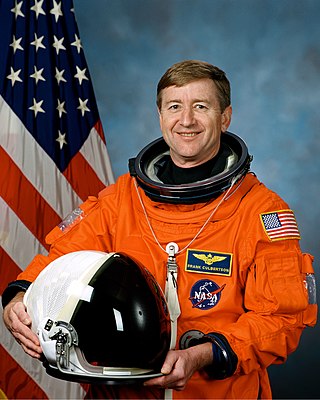
Frank Lee Culbertson Jr. is an American former naval officer and aviator, test pilot, aerospace engineer, NASA astronaut, graduate of the US Naval Academy, and member of the United States Astronaut Hall of Fame. He served as the commander of the International Space Station for almost four months in 2001 and was the only U.S. citizen not on Earth when the September 11 attacks occurred.

Steven Wayne Lindsey is a retired U.S. Air Force officer and NASA astronaut. Lindsey served as Chief of the NASA Astronaut Office from September 2006 until October 2009.

Richard Alan Mastracchio is an American engineer and former NASA astronaut. He has flown on three NASA Space Shuttle missions as a mission specialist in addition to serving as a flight engineer on the Soyuz TMA-11M long-duration mission aboard the International Space Station. He is currently the senior director of operations for commercial resupply services at Orbital ATK.
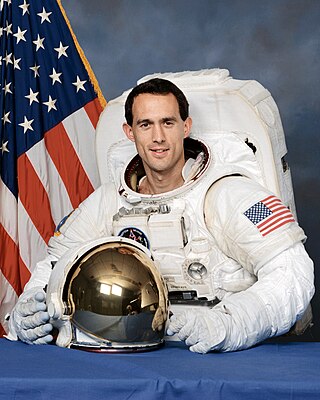
James Hansen Newman is an American physicist and a former NASA astronaut who flew on four Space Shuttle missions.
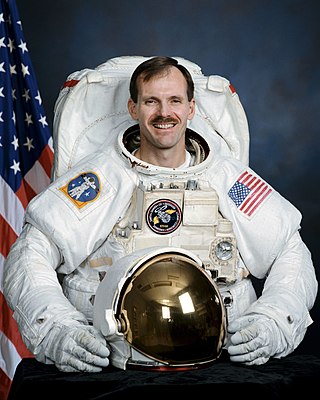
Steven Lee Smith, is an American technology executive and a former NASA astronaut, being a veteran of four space flights covering 16 million miles and seven spacewalks, totaling 49 hours and 25 minutes. Smith’s spacewalk time places him in 14th on the all-time American and World spacewalk duration lists.

James Shelton Voss is a retired United States Army colonel and NASA astronaut. During his time with NASA, Voss flew in space five times on board the Space Shuttle and International Space Station. He also served as deputy of Flight Operations for the Space Station Program Mission Integration and Operations Office. While participating in ISS Expedition 2, he and Susan Helms conducted an 8-hour and 56 minute spacewalk, the longest to date.

Rex Joseph Walheim is a retired United States Air Force officer, engineer and NASA astronaut. He flew three Space Shuttle missions, STS-110, STS-122, and STS-135. Walheim logged over 566 hours in space, including 36 hours and 23 minutes of spacewalk (EVA) time. He was assigned as mission specialist and flight engineer on STS-135, the final Space Shuttle mission.

STS-121 was a 2006 NASA Space Shuttle mission to the International Space Station (ISS) flown by Space ShuttleDiscovery. The main purposes of the mission were to test new safety and repair techniques introduced following the Columbia disaster of February 2003 as well as to deliver supplies, equipment and German European Space Agency (ESA) astronaut Thomas Reiter to the ISS.
Space Shuttle missions designated STS-3xx were rescue missions which would have been mounted to rescue the crew of a Space Shuttle if their vehicle was damaged and deemed unable to make a successful reentry. Such a mission would have been flown if Mission Control determined that the heat shielding tiles and reinforced carbon-carbon panels of a currently flying orbiter were damaged beyond the repair capabilities of the available on-orbit repair methods. These missions were also referred to as Launch on Demand (LOD) and Contingency Shuttle Crew Support. The program was initiated following loss of Space Shuttle Columbia in 2003. No mission of this type was launched during the Space Shuttle program.
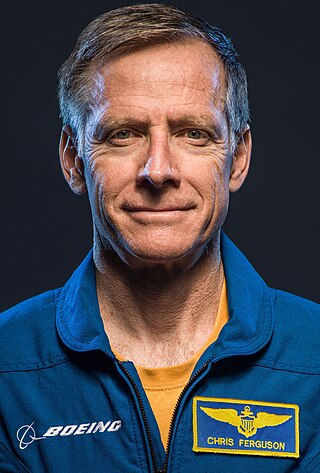
Christopher J. "Fergy" Ferguson is a Boeing commercial astronaut and a retired United States Navy captain and NASA astronaut. He was the pilot of Space Shuttle Atlantis on his first mission to space, STS-115, which launched on September 9, 2006, and returned to Earth on September 21, 2006. He then commanded STS-126 aboard Space ShuttleEndeavour. In 2011, he was assigned as commander of STS-135, which was the final mission of the space shuttle program.
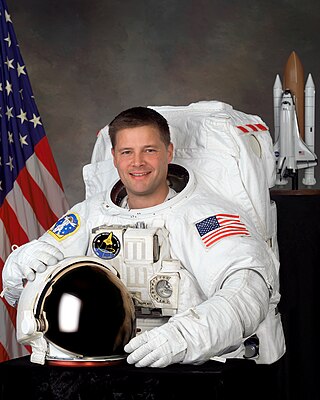
Douglas Harry "Wheels" Wheelock is an American engineer and astronaut. He has flown in space twice, logging 178 days on the Space Shuttle, International Space Station, and Russian Soyuz. On July 12, 2011, Wheelock announced that he would be returning to active duty with the United States Army in support of Operation Enduring Freedom. He is currently working with NASA to test the Orion spacecraft at the Glenn Research Center in Plum Brook, Ohio.
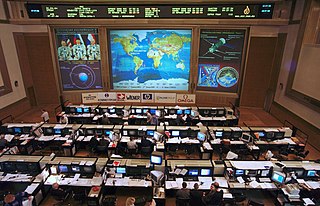
Flight controllers are personnel who aid space flight by working in such Mission Control Centers as NASA's Mission Control Center or ESA's European Space Operations Centre. Flight controllers work at computer consoles and use telemetry to monitor various technical aspects of a space mission in real-time. Each controller is an expert in a specific area and constantly communicates with additional experts in the "back room". The flight director, who leads the flight controllers, monitors the activities of a team of flight controllers, and has overall responsibility for success and safety.
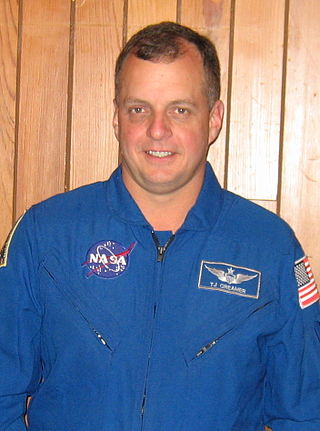
Timothy John "T. J." Creamer is a NASA flight director, retired astronaut and a colonel in the United States Army. Creamer was born in Fort Huachuca, Arizona, but considers Upper Marlboro, Maryland, to be his hometown. He is married to the former Margaret E. Hammer. They have two children.
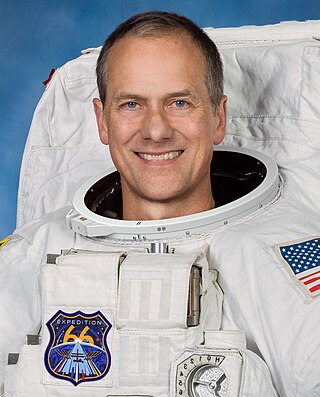
Thomas Henry Marshburn is an American physician and a former NASA astronaut. He is a veteran of three spaceflights to the International Space Station and holds the record for the oldest person to perform a spacewalk at 61 years old.

NASA's Christopher C. Kraft Jr. Mission Control Center, also known by its radio callsign, Houston, is the facility at the Lyndon B. Johnson Space Center in Houston, Texas, that manages flight control for the United States human space program, currently involving astronauts aboard the International Space Station (ISS). The center is in Building 30 at the Johnson Space Center and is named after Christopher C. Kraft Jr., a NASA engineer and manager who was instrumental in establishing the agency's Mission Control operation, and was the first Flight Director.

STS-135 was the 135th and final mission of the American Space Shuttle program. It used the orbiter Atlantis and hardware originally processed for the STS-335 contingency mission, which was not flown. STS-135 launched on July 8, 2011, and landed on July 21, 2011, following a one-day mission extension. The four-person crew was the smallest of any shuttle mission since STS-6 in April 1983. The mission's primary cargo was the Multi-Purpose Logistics Module (MPLM) Raffaello and a Lightweight Multi-Purpose Carrier (LMC), which were delivered to the International Space Station (ISS). The flight of Raffaello marked the only time that Atlantis carried an MPLM.
